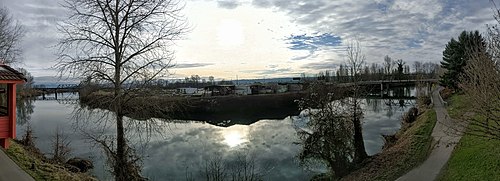Snohomish River
 From Wikipedia - Reading time: 8 min
From Wikipedia - Reading time: 8 min
| Snohomish River | |
|---|---|
 Snohomish River in Snohomish, Washington | |
 Map of the Snohomish River and tributaries | |
| Location | |
| Country | United States |
| State | Washington |
| County | Snohomish |
| Physical characteristics | |
| Source | Confluence of the Skykomish River and the Snoqualmie River |
| • location | Monroe |
| • coordinates | 47°49′48″N 122°2′47″W / 47.83000°N 122.04639°W[1] |
| Mouth | Puget Sound |
• location | Port Gardner |
• coordinates | 48°1′16″N 122°12′30″W / 48.02111°N 122.20833°W[1] |
• elevation | 0 m (0 ft) |
| Length | 20 mi (32 km)[2] |
| Basin size | 1,856 sq mi (4,810 km2)[3] |
| Discharge | |
| • location | Near Monroe[4] |
| • average | 9,511 cu ft/s (269.3 m3/s)[4] |
| • minimum | 763 cu ft/s (21.6 m3/s) |
| • maximum | 150,000 cu ft/s (4,200 m3/s) |
The Snohomish River is a river in Snohomish County, Washington, formed by the confluence of the Skykomish and Snoqualmie rivers near Monroe. It flows northwest entering Port Gardner Bay, part of Puget Sound, between Everett and Marysville. The Pilchuck River is its main tributary and joins the river at Snohomish. The river system drains the west side of the Cascade Mountains from Snoqualmie Pass to north of Stevens Pass.
Measured at Monroe, the Snohomish River has an average annual flow of 9,500 cubic feet per second (270 m3/s).[2] In comparison, the Columbia River, Washington's largest river, has an average flow of about 265,000 cubic feet per second (7,500 m3/s).[5]
Course
[edit]

The Snohomish River forms at the confluence of the Snoqualmie and Skykomish Rivers just west of Monroe. Both of these rivers originate in the Cascades and drain the west slopes of the mountains in southeastern Snohomish County and northeastern King County. The Snohomish River flows generally northwestward from the confluence, passing under state route 522 and flowing alongside Lord Hill Regional Park before reaching downtown Snohomish. Here, it is joined by the Pilchuck River, its main tributary, and flows under state route 9. From Snohomish, the river continues northwestward through a broad floodplain, forming the eastern boundary of the city of Everett. The final few miles of the river in Everett form the Snohomish River estuary, a river delta that features wetlands and tideflats spread out across various islands and arms of the river.[6] Several bridges carry U.S. Route 2, Interstate 5, and State Route 529 across the delta. The river then empties into Possession Sound, which is part of Puget Sound, between Everett and Marysville.
Human history
[edit]In November 2024, a ballot measure in the City of Everett proposed personhood and rights for the Snohomish River itself within the city limits.[7] It was approved by voters and allows residents to file lawsuits on behalf of the river.[8]
Pollution
[edit]The lower Snohomish River was a site of major industry during the 20th century that contaminated the area with various pollutants, including oil and fuel products from former mills and factories. An ore smelter operated by ASARCO contaminated soil and groundwater near the Snohomish River with arsenic.[9] The river has also been used a site for illegal dumping of tires, litter, and batteries.[10] The county government began a program to remove derelict vessels, including old boats, in the Snohomish River delta in 2018; by 2023, the program had removed 27 vessels that had leaked pollutants into the river.[11]
See also
[edit]References
[edit]- ^ a b U.S. Geological Survey Geographic Names Information System: Snohomish River
- ^ a b Snohomish River Watershed Draft Initial Assessment Archived 2006-10-04 at the Wayback Machine
- ^ Surface Water Management Division: Snohomish River Salmon Recovery
- ^ a b USGS Snohomish River gauge near Monroe
- ^ Kammerer, J.C. (May 1990). "Largest Rivers in the United States". U.S. Geological Survey. Retrieved 2008-04-01.
- ^ Brennick, Charles. "Snohomish River Estuary Recreation Guide". Snohomish County Estuary. Snohomish County government. Retrieved July 11, 2019.
- ^ Aronson, Eliza (November 1, 2024). "Everett initiative asks: Should the Snohomish River have legal rights". The Everett Herald. Retrieved November 5, 2024.
- ^ Geschke, Will (November 6, 2024). "Voters approving Everett minimum wage, Snohomish River rights measures". The Everett Hreald. Retrieved November 29, 2024.
- ^ Sanders, Julia-Grace (September 30, 2020). "Port of Everett's next cleanup will bring jobs, public access". The Everett Herald. Retrieved December 30, 2023.
- ^ Bryan, Zachariah (May 22, 2022). "Diving for trash in Snohomish River, biologist fills 59 pickup beds". The Everett Herald. Retrieved December 30, 2023.
- ^ Van Sistine, Ta'Leah (December 30, 2023). "'My river': Locals take it upon themselves to clean up the Snohomish". The Everett Herald. Retrieved December 30, 2023.
External links
[edit]- Snohomish River at Snohomish County website
 KSF
KSF

